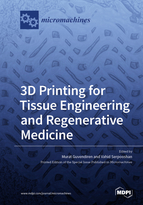3D Printing for Tissue Engineering and Regenerative Medicine
A special issue of Micromachines (ISSN 2072-666X). This special issue belongs to the section "B:Biology and Biomedicine".
Deadline for manuscript submissions: closed (30 September 2019) | Viewed by 48005
Special Issue Editors
Interests: hydrogels; polymeric biomaterials; 3D bioprinting; biomimetics; stem cells
Special Issues, Collections and Topics in MDPI journals
Interests: biomanufacturing; 3D bioprinting; cardiovascular tissue engineering; nano-biomaterials
Special Issues, Collections and Topics in MDPI journals
Special Issue Information
Dear colleagues,
Three-dimensional (3D) printing enables the fabrication of tissue-engineered constructs and devices from a patient’s own medical data, leading to creation of anatomically-matched and patient-specific constructs. There is a growing interest in applying 3D printing technologies in the fields of tissue engineering and regenerative medicine. The main printing methods include extrusion-based, vat photopolymerization, droplet-based, and powder-based printing. A variety of materials have been used for printing, from metal alloys and ceramics to polymers, elastomers, and hydrogels to extracellular matrix proteins. More recently, bioprinting, a subcategory of 3D printing, has enabled the precise assembly of cell-laden biomaterials (i.e., bio-inks) for the construction of complex 3D functional living tissues or artificial organs.
In this Special Issue, we aim to capture state-of-the-art research papers and the most current review papers focusing on 3D printing for tissue engineering and regenerative medicine. In particular, we seek novel studies on the development of 3D printing and bioprinting approaches, developing printable materials (inks and bio-inks), and utilizing 3D-printed scaffolds for tissue engineering and regenerative medicine applications. These applications are not limited to but include scaffolds for in vivo tissue regeneration and tissue analogues for in vitro disease modeling and/or drug screening.
Dr. Murat Guvendiren
Dr. Vahid Serpooshan
Guest Editors
Manuscript Submission Information
Manuscripts should be submitted online at www.mdpi.com by registering and logging in to this website. Once you are registered, click here to go to the submission form. Manuscripts can be submitted until the deadline. All submissions that pass pre-check are peer-reviewed. Accepted papers will be published continuously in the journal (as soon as accepted) and will be listed together on the special issue website. Research articles, review articles as well as short communications are invited. For planned papers, a title and short abstract (about 100 words) can be sent to the Editorial Office for announcement on this website.
Submitted manuscripts should not have been published previously, nor be under consideration for publication elsewhere (except conference proceedings papers). All manuscripts are thoroughly refereed through a single-blind peer-review process. A guide for authors and other relevant information for submission of manuscripts is available on the Instructions for Authors page. Micromachines is an international peer-reviewed open access monthly journal published by MDPI.
Please visit the Instructions for Authors page before submitting a manuscript. The Article Processing Charge (APC) for publication in this open access journal is 2600 CHF (Swiss Francs). Submitted papers should be well formatted and use good English. Authors may use MDPI's English editing service prior to publication or during author revisions.
Keywords
- Additive manufacturing
- 3D printing
- 3D bioprinting
- Biofabrication
- Bio-ink
- Tissue engineering
- Regenerative medicine
- Microfabrication technologies
- Scaffold design








